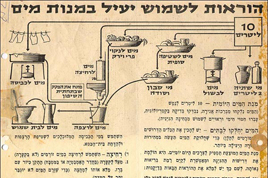The winter storm that hit our region also brought with it a flurry of media cliches, including the highly inaccurate “Jerusalem is under siege”.
Now, now. Conditions are not good, many homes are still without power, roads not cleared, food deliveries delayed and today’s so-called “warmer” weather has only created a more dangerous threat to pedestrians and drivers alike: layers of ice.
It’s bad but hardly a siege and Jerusalem knows about sieges, having been through many, from 1000 BC on up. An online exhibition presented by the IDF Archive of the blockade of Jerusalem that lasted from February 1948 through June 1948 provides primary sources about life during that most recent Siege of Jerusalem.
According to Wikipedia, “Starting in early 1948, the Arab forces had severed the supply line to Jewish Jerusalem.”

“On 31 March, the head of the Jerusalem Emergency Committee, Dr. Dov Yosef, introduced a draconian system of food rationing.

“On 12 May, water rationing was introduced. The ration was 2 gal/person/day, of which 4 pints was drinking water.”
Instructions for the daily water allocation were distributed that explained how to effectively use and reuse 10 liters of water for all one’s needs from drinking and cooking to washing dishes, bathing, washing clothes and flushing.

“The bread ration was 200 grams per person. The April Passover week ration per person was 2 lb potatoes, 2 eggs, 0.5 lb fish, 4 lb matzoth, 1.5 oz dried fruit, 0.5 lb meat and 0.5 lb matza flour… In June the weekly ration per person was 100 g wheat, 100 g beans, 40 g cheese, 100 g coffee or 100 g powdered milk, 160 g bread per day, 50 g margarine with 1 or 2 eggs for the sick.”
An urgent telegram sent on May 26, 1948 by Dov Yosef to Prime Minister David Ben Gurion and Head of Operations Yigael Yadin, reads: “I do not want to burden you, and I’m trying to preserve the public mood, but there are just a few days left of food [reserves]. Any delay may be dangerous. Do you see a possibility of sending supplies by airplane? If so – let me know what how much weight [can be dropped] per day, and according to that we will determine our needs.”

A circular was issued by the Jerusalem Committee of the Central Emergency Authority to bolster morale. It reads in part: “Jews of Jerusalem! Do not despair and do not fear. We will bear our suffering with pride, vigilant and disciplined in advance of the days to come. Imbued with the righteousness of our war, we will make our contribution until liberation comes.”

The end of the siege came in June with the opening of the Burma Road, a makeshift bypass between the vicinity of Kibbutz Hulda and Jerusalem. The news is delivered dryly in a telegram sent from the Quartermaster Division of the Traffic Supervision Department to the Blockade Squad at Hulda. It reads in part, “Road to Jerusalem open. Traffic from here from 20.00 (8:00 PM). Day traffic only in special cases.”

Today too, the roads were opened to traffic and it appears that storm has passed leaving only a trail of media mud-slinging and political blame-casting in its wake. That’s fine and business as usual. Just don’t call it a siege — Jerusalem has seen worse.














